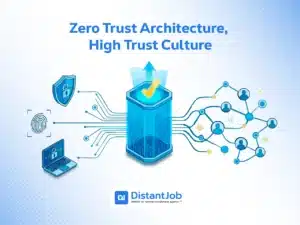The technology sector has endured a tumultuous 18 months. In 2023, over 200,000 employees lost their jobs due to the economic downturn and inflation. The downsizing of the workforce continued in the early part of 2024.
However, things are gradually looking up. In fact, IT staffing is expected to increase by 3-5% before the end of the year. That means IT professionals will be in high demand again.
But what does that mean for you as an employer, and how can you position yourself to attract the best tech talents? In this article, we explore the latest IT staffing trends to help you answer these questions.
What is IT Staffing?
Information technology staffing, or IT staffing, is the process of finding and hiring qualified candidates to fill technology positions in your organization. These roles include software development, web development, system administration, and network engineering.
A company’s HR department can handle IT staffing, or it could employ third-party staffing agencies like DistantJob. Opting for staffing agencies gives you access to their large pool of qualified IT candidates. As a result, you can quickly and efficiently fill up open positions.
Staffing Industry Statistics in 2024
The most recent report by Statista reveals that staffing agencies helped 62.2 million job seekers worldwide find employment. That accounted for 12.7 million people in the US IN 2023, a 16.8% decrease compared to its historic levels in 2022. Despite the reduced figure, it shows how pivotal the staffing industry is to the job market.
Here are the projected figures for 2024.
- According to the SIA (Staffing Industry Analysts), the staffing industry generated $654 billion in revenue in 2022 and is forecast to be worth $665 billion in 2024.
- The US is the biggest staffing market in the world, accounting for nearly one-third of the revenue generated. In fact, it outperforms the next three largest markets in Japan, the UK, and Germany’s combined revenue.
- The US staffing industry is expected to generate $207.4 billion in 2024, as per the SIA.
- According to 44% of respondents, the priority of global staffing companies in 2024 is winning new clients. Digital transformation and candidate acquisition complete the top three priorities, with 30% of respondents naming the former and the latter.
- Nearly 2.4 million temporary and contract employees work for America’s staffing companies during an average week in 2024.
- 57% of recruitment professionals say a limited talent pool is their top hiring challenge
- Almost 90% of workers want their employer to remove the locked monthly pay cycle.
- It takes staffing agencies 17-19 days on average to fill one job role
What is the Outlook for IT Staffing?
The IT staffing market is estimated to be worth $118.95 billion in 2024 and is expected to reach $142.37 billion by 2026. That means it will grow at a CAGR of 3.66% during the forecast period (2024-2029).
The market’s growth is due to an increase in the outsourcing of HR activities and the emergence of technologies, such as AI (artificial intelligence) and IoT (Internet of Things), which are expected to create strong demands for IT professionals.
The following are the trends shaping IT staffing this year.
1. The Rise of Remote Work
In the past, remote work was a nice perk for many organizations, like having a pool table or a fully stocked snack bar in the office. Today, however, professionals are heavily leaning towards telecommuting.
According to research, 95% of them want to work remotely, and only 5% want to work from the office. These numbers are not surprising considering the immense benefits of telecommuting. Remote work enables employees to save money, eliminates commute time, and improves work-life balance.
It also benefits employers because they can save more on each employee, access a global talent pool, and have a happier workforce. A study conducted by Tracking Happiness revealed that working remotely increased workers’ happiness by 20%.
What to do as an employer:
The first step is to accept that remote work is here to stay. Companies that don’t embrace this new working model will lose out on top tech talents. Next, incentivize prospective hires with the option of a remote or hybrid arrangement.
Expand your database of potential candidates by searching for ideal matches globally. Leverage online platforms to reach a wider audience and promote job openings. Take things a step further by giving new hires a stipend to set up their remote office, and you can truly stand out.
2. AI and Automation in Recruitment
No industry will be impacted by the advancement in technologies like AI and machine learning than the tech. So, if you are in the IT staffing sector, you must stay on top of these innovations.
These systems already help staffing companies streamline redundant and time-consuming tasks. For example, the adoption of Candidate Relationship Management (CRM), Applicant Tracking Systems (ATS), and digital interview platforms are changing the roles of staffing professionals.
In 2024, companies will deploy automation to handle tasks like candidate screening and initial screening, especially with the emergence of asynchronous video technology. With this technology, applicants can record their responses to questions. Hence, companies can use video technology to shorten the applicant-to-hire process.
What to do as an employer:
The emergence of artificial intelligence and machine learning has been met with mixed reactions. Some people are worried that it could make many professionals redundant, while others think it is a good thing. Regardless of where you sit, you need to stay in the loop.
That way, you can leverage it to keep up with demands and shifts in IT staffing trends. It also speaks well of you and your organization. Being able to share insights on these trends with potential clients and employees increases your credibility and reputation.
3. Demand for Specialized Skills
Companies across different industries are undergoing a digital transformation. As a result, they’re integrating digital technologies, such as AI, cloud computing, and blockchain, into their operations.
To grasp the magnitude of this change, you only need to look at the number of startups that have emerged in recent years.
However, finding the right candidates to fill the positions created by this advancement is easier said than done. According to the 2023 State of Tech Talents by Linux, companies focus mainly on cybersecurity, cloud computing, and AI/ML when hiring new employees.
So, what can you do as an employer?
What to do as an employer:
Work with your internal recruitment team to build a database of potential candidates who possess these skills. Another option is to partner with a staffing company like DistantJob. It is faster and cheaper than hiring a full-time recruiter. Plus, you get access to our extensive pool of pre-qualified candidates with expertise in these in-demand skills.
4. Emphasis on Soft Skills
Tech professionals must also possess soft skills, as they often work with cross-functional teams. This means they must know how to communicate effectively and collaborate with team members with different backgrounds and expertise.
For example, in a remote dev team, a software engineer from the United States may have to work with a UX designer who isn’t a native speaker. Therefore, skills like emotional intelligence, critical thinking, adaptability, and more are critical.
Moreover, these skills are almost impossible to teach, which makes them even more valuable.
What to do as an employer:
When sourcing for talent, consider if the candidate is a fit for your team. That means looking beyond their ability to code or design. Assess their ability to adapt, solve problems, manage workloads, and so on.
Now, because these skills are immeasurable, it can be tricky to identify them if you are not a professional recruiter. So, this is another situation where teaming up with an experienced recruitment agency can help. Some of these agencies, like ours, have recruitment managers who are skilled at recognizing these essential qualities in potential hires.
5. Diversity and Inclusion Initiatives
Diversity, equity, and inclusion (DEI) is no longer a buzzword. It is an approach to talent management that prioritizes creating a welcoming and safe workplace for everyone, irrespective of their race, gender, age, etc.
It is a concept that has continued to gain momentum yearly, and 2024 won’t be different. This is echoed by 92% of business leaders who agree that a strategic workforce education program should help a company achieve DEI goals.
Your potential employees are also conscious of this initiative and will only work for companies that implement it. According to research, 63% of employees prioritize DEI programs when choosing an employer.
DEI isn’t just a moral obligation, either. It has business benefits, especially in the IT industry. Tech companies thrive on innovation, and diversity fosters this by bringing together individuals with different perspectives, experiences, and ideas. The numbers back this up, too: diverse and inclusive teams are 35% more likely to outperform their competitors.
What to do as an employer:
Incorporate DEI into the core of your IT staffing process. However, ensure they align with your business objectives. That means you shouldn’t hire a candidate just to fill a diversity quota. Ensure that they have the relevant skills and are a cultural fit. But develop hiring strategies that give every applicant an equal opportunity. The idea is to find the balance between competence and diversity.
6. Growth of Freelance and Gig Economy
The gig economy is here, and the technology industry is a big part of it. In 2023, there were 73.3 million freelancers in the USA, and that number is expected to rise to 76.4 million in 2024.
Freelancing platforms like Upwork, Fiverr, and Guru match tech talents with clients worldwide. As a result, employers can access specialized skills on demand and save costs.
For IT professionals, they can have flexible schedules and augment their income — a win-win for all parties.
What to do as an employer:
Move with the times. People want more control over their time, so they are opting for flexible work arrangements. Use freelance platforms to find tech professionals who seek this type of work environment. Social networking sites like LinkedIn and X are reliable ways to connect with potential candidates. Plus, you can be explicit about offering flexible work options in your job ads.
How to Adapt Your Company to These Changes
To cope with the evolving trends in IT staffing, you need to adapt your company’s recruiting strategy. Here are some tips to do that:
- Embrace flexible staffing options: An effective IT staffing strategy must include flexible working arrangements. Permanent, temporary, and contract-to-hire options give your business the agility to adjust to changing market demands.
- Craft an IT recruitment and retention plan: How you describe the role and the skills required matters. Having an IT recruitment and retention plan enables you to source and hire IT talents who align with your business needs. You should also invest in upskilling your current workforce to improve retention rates.
- Make data-driven IT staffing decisions: Data can help you make informed decisions for now and the immediate future. Analyze past performance, turnover rates, and skills gaps. Then, you can modify your strategy to improve results. Moreover, performance metrics give you a comprehensive view of your progress and areas that need attention.
Meet DistantJob
IT staffing trends help you anticipate changes in the job market and position yourself for success. They inform your hiring strategy and increase your chance of hiring the right tech talents, which is tricky nowadays.
However, you can better those odds by partnering with us. We offer global IT staffing services, which means we target specific candidates to bring you the most talented IT professionals. Our HR follows the whole process and ensures a long and stable relationship. If you still have questions, just contact us!





